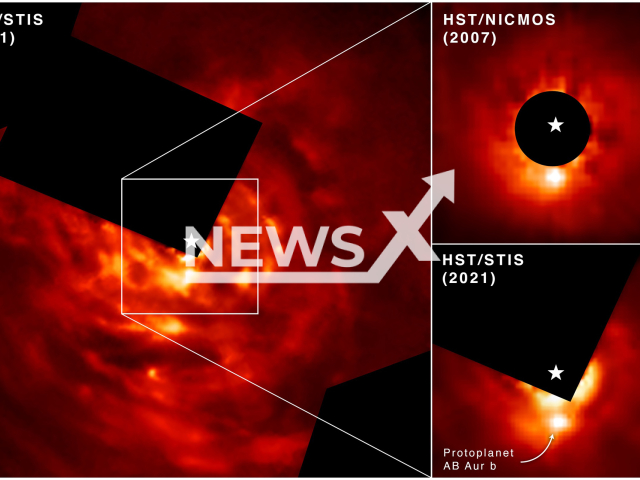 Researchers were able to directly image newly forming exoplanet AB Aurigae b over a 13-year span using Hubble’s Space Telescope Imaging Spectrograph (STIS) and its Near Infrared Camera and Multi-Object Spectrograph (NICMOS). In the top right, Hubble’s NICMOS image captured in 2007 shows AB Aurigae b in a due south position compared to its host star, which is covered by the instrument’s coronagraph. The image captured in 2021 by STIS shows the protoplanet has moved in a counterclockwise motion over time. Note: NASA photo. (NASA, ESA, Thayne Currie (Subaru Telescope, Eureka Scientific Inc./Newsflash)
Researchers were able to directly image newly forming exoplanet AB Aurigae b over a 13-year span using Hubble’s Space Telescope Imaging Spectrograph (STIS) and its Near Infrared Camera and Multi-Object Spectrograph (NICMOS). In the top right, Hubble’s NICMOS image captured in 2007 shows AB Aurigae b in a due south position compared to its host star, which is covered by the instrument’s coronagraph. The image captured in 2021 by STIS shows the protoplanet has moved in a counterclockwise motion over time. Note: NASA photo. (NASA, ESA, Thayne Currie (Subaru Telescope, Eureka Scientific Inc./Newsflash)
Copyrights: NASA, ESA, Thayne Currie (Subaru Telescope, Eureka Scientific Inc./Newsflash
06 April 2022
Category
A massive new planet, nine times the size of Jupiter and almost 12,000 times bigger than Earth, is being formed in an intense and violent process that is challenging understanding about planetary formation. NASA's Hubble space telescope recorded the new planet, called AB Aurigae b, which is...